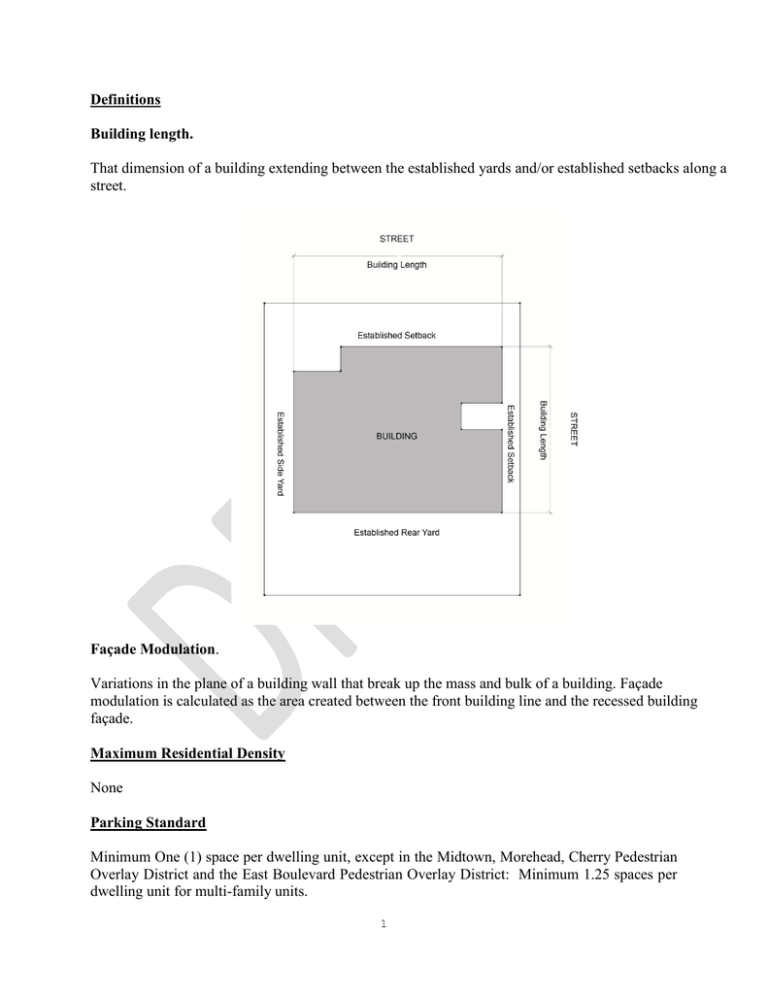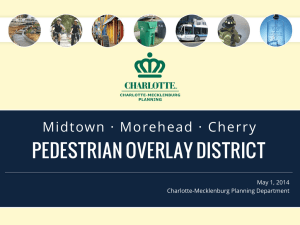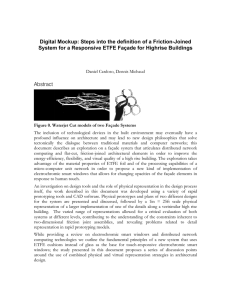Definitions Building length.
advertisement

Definitions Building length. That dimension of a building extending between the established yards and/or established setbacks along a street. Façade Modulation. Variations in the plane of a building wall that break up the mass and bulk of a building. Façade modulation is calculated as the area created between the front building line and the recessed building façade. Maximum Residential Density None Parking Standard Minimum One (1) space per dwelling unit, except in the Midtown, Morehead, Cherry Pedestrian Overlay District and the East Boulevard Pedestrian Overlay District: Minimum 1.25 spaces per dwelling unit for multi-family units. 1 Supplemental Design Standards All new buildings and uses located within the boundaries of the Midtown, Morehead, Cherry Pedestrian Overlay District and the East Boulevard Pedestrian Overlay District shall be subject to the requirements of Section 10.813(1) plus the following minimum standards: (a) Large scale building facades where the total building length is greater than two-hundred fifty (250) feet shall include one or more of the following features to achieve pedestrian scale and break down the building mass and bulk: 1. Façade Modulation is intended to create variations in the façade to break up large building masses. The minimum amount of façade modulation shall be 5 square feet per each linear foot of building length fronting a street. Each modulation shall be open to the sky with a minimum width of 10 feet and minimum depth of 10 feet, as measured from the front building line. This calculated amount of modulation may be distributed along the building length within multiple modulations. Modulations shall occur at intervals no greater than 200’ in length. 2 2. Building Mass Separation is intended to break up long, continuous building walls and create the appearance of multiple buildings. Building mass separation shall be provided at a depth of at least 25 feet from the front building line and a width of at least 25 feet, open to the sky, for at least every 200 feet of total building length fronting a street. 3. Architectural Variation is intended to create the appearance of smaller, attached buildings and reduce the apparent size of a building. The Planning Director, or his or her authorized designee, shall have the authority to approve an alternative design that incorporates architectural variations along public rights-of-way. The alternative design shall utilize a combination of the following, at increments no greater than 100’, to break up the building mass: varied roof pitches, building heights, architectural styles, window arrangement and size variations, external building material changes, and/or offset wall planes. (b) All buildings over five stories shall be designed with an architectural base distinguishable from the remainder of the building to enhance the pedestrian environment. The base shall not be more than two stories in height and shall utilize a combination of the following: cornices, belt courses, molding, stringcourses, ornamentation, changes in color and material, or other sculpting of the base. 3


